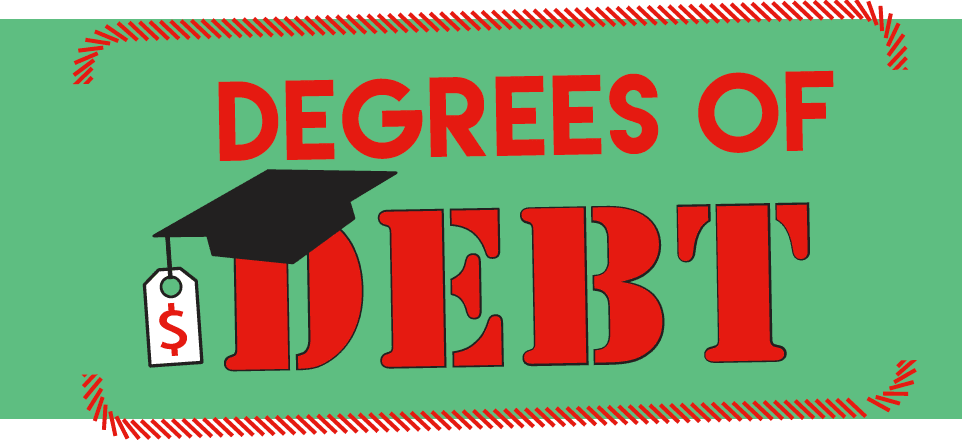“Degrees of Debt: What to Do About Rising College Debt in Texas” is a three-part data series by the Center for Public Policy Priorities. Part 2/3
Part 1: Why Is Texas Investing Less and Expecting Better College Graduation Rates?
Part 3: College Students Left to Fend for Themselves as State Support Declines
Postsecondary education is critical for driving prosperity for all Texas families. The high cost of postsecondary education and dwindling financial aid, however, make it hard for students to afford a postsecondary education. This is especially true for so-called non-traditional students such as part-time and financially independent students.
The cost of postsecondary education in Texas has been consistently rising, with Texas families assuming more and more of the cost of higher education. While the staggering costs of postsecondary education negatively impact all Texans, certain students face unique challenges that are critical to address in order for the state to meet its higher education goals. The state’s 60x30TX plan calls for 60 percent of adults ages 25-34 earning a degree or certificate by 2030.
The state provides financial aid to students who demonstrate need through either the federal or state application process (Free Application for Federal Student Aid (FAFSA) or Texas Application for Student Financial Aid (TASFA)). The most common forms of state financial aid are the TEXAS Grant (4-year public university students) and the Texas Educational Opportunity Grant (2-year public college students).
The number of students that the state reaches with its financial aid programs is quite low, with 2-year, part-time, and independent students particularly disadvantaged. It’s critical that we invest in higher education access now to ensure prosperity for all Texans in the future.
Lawmakers have chosen to limit state funding for financial aid, and they have focused the limited funding on full-time students attending 4-year public universities. Students attending universities have to pay more for their education than students in public community colleges, and evidence shows that students attending full-time are more likely to graduate.
The decision to focus on 4-year public college and university students, however, means that the state provides little or no assistance to non-traditional students. Especially under-supported are people who could benefit greatly from support such as those who, due to financial or familial constraints, are unable to attend full-time, who do not have additional financial support from their families, or who decide to begin their postsecondary education at a community college.
2-Year Students
In fall 2017, there were more than 700,000 students enrolled in public 2-year colleges in Texas, an enrollment of nearly 100,000 more students than at public 4-year universities in the same period. Even public and independent universities combined barely topped the 2-year public college enrollment by a few thousand.
About 47 percent of post-secondary students in Texas attend 2-year universities, but they receive little state support when compared to those at 4-year universities.1 In 2016, nine percent of 2-year full-time students with financial need received state aid compared to 20 percent of their counterparts at 4-year universities.
About 47 percent of post-secondary students in Texas attend 2-year universities, but they receive little state support when compared to those at 4-year universities[i]. In 2016, nine percent of 2-year full-time students with financial need received state aid compared to 20 percent of their counterparts at 4-year universities.

Part-Time Students
Between 2008 and 2016, the number of part-time students at 4-year universities increased by 78 percent, and the number of part-time students at 2-year colleges rose by 80 percent.
In 2016, however, only two percent of part-time students at 4-year schools received state aid compared to 20 percent of full-time students.

Independent Students
“Financially-independent students” is what the state calls students over 24, and students who are parents, veterans, orphans, or those who are homeless. “Financially independent” is a misleading name, as these students often struggle and are some of the most overlooked and underfunded in Texas.
Independent students who receive state aid receive less than their financially dependent counterparts, and independent students without state aid take out more in loans than any other subpopulation identified in this analysis.
Despite their unique need, Texas only provides state aid to five percent of full-time, independent students.

Existing Aid Isn’t Enough
While the aid students currently receive is critical, it does not go far enough to cover the rising costs of postsecondary education. Among the few full-time, 4-year students who received financial support, 90 percent of them still had unmet financial need, despite their financial aid award.
For Texas to reach its postsecondary education goals, the state should continue and strengthen support to students currently receiving aid. But Texas should also expand the aid that goes to students who don’t fit traditional definitions including community college, part-time, and independent students.
The soaring cost of postsecondary education is a financial hardship for Texas students and families that may already be having profound implications for the state’s economic future. How many Texans have already found themselves priced out of a postsecondary education? How many will increasingly miss out on a financially secure future if Texas does not take action to support all students, including the non-traditional Texans pursuing a postsecondary education? It’s time to invest in financial aid for all Texas students, including non-traditional students.
[i] All estimates are an average in 2016 dollars. The tuition and fee data included here are the amounts reported as net tuition and fees in the Sources and Uses Reports from the Texas Higher Education Coordinating Board, and do not include scholarships, exemptions & waivers offered by the institution from its revenue sources. Tax Collections are listed as Tax Collection in the Sources and Uses Reports
